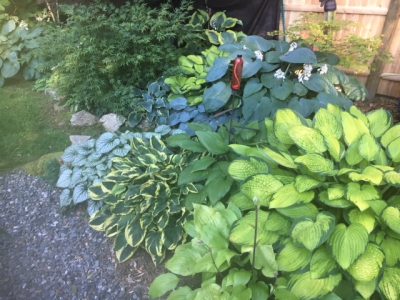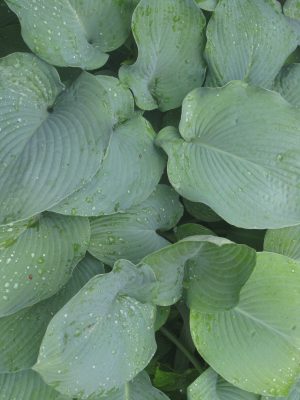By Dawn Pettinelli, UConn Home & Garden Education Center

So versatile and ubiquitous are hostas that I have yet to visit a garden that doesn’t have at least one whether left by a previous gardener or selected by the present one. Hostas certainly are workhorses of the garden renowned for their shade tolerance, hardiness and longevity. Plus, few plants have such large variations in size, leaf color and texture. According to the American Hosta Society, there are more than 3000 varieties of hostas covering 45 species including stalwarts of our gardens such as Hosta sieboldiana, H. elegans and H. montana. Now the hostas you purchase are likely complex crosses of multiple species.
Hostas are native to Asia and came to the United States through Europe during the 1800s. Many of us older gardeners referred to them as plantain lilies because their broad leaves resemble a common weed (or herb depending on one’s perspective), plantain. The young leaves are reputedly edible. In fact, the Japanese are said to serve them raw, boiled or fried in tempura. Their palatability probably explains why gardeners around here half-jokingly refer to them as ‘deer candy’.
Hostas are divided by size into 5 groups. Minis are less than 6 inches tall, small range from 7 to 10 inches, medium from 11 to 18, large from 19 to 28, and giants are greater than 28 inches. ‘Gentle Giant’ and ‘Empress Wu’ are close to 4 feet tall with a spread of over 5 feet, if you’re looking for a plant to make a voluminous impression. Keep in mind a plant’s full size when incorporating them into your planting beds.
A notable feature of many hosta cultivars is leaf variegation. On marginally variegated plants the edges of the leaves are light in color, maybe cream or yellow. Medio variegated types have light colored centers with darker edges. There are also 5 groupings for color: green, blue and gold, plus the 2 types of variegation. The gold and variegated cultivars do best in part sun to dappled shade. Placed in a heavily shaded area, they can lose some of their color as only the green parts of the leaves photosynthesize.

Leaf shapes range from thin and smooth to ridged and heart shaped. Sizes range from 2 inches on ‘Mouse Ears’ to over a foot and a half on giant hostas.
While grown mainly for their attractive foliage, hostas do bloom once a year. Most have delicate-looking, tubular flowers in various shades of purple that are attractive to hummingbirds and bees. Fragrant white ‘Royal Standard’ grace part of a patio in my white garden. Their heady scent is especially pronounced on warm summer evenings. ‘Royal Wedding’ is another fragrant, white-flowering variety. Cut down the flower stalks once flowering is finished.
Growing hostas is a breeze. These tough, dependable plants put on their best show when not located in full sun as the large leaves can scorch during periods of hot, sunny weather. That being said, there are some cultivars like ‘Guacamole’ and ‘Paradigm’ which can tolerate full sun with adequate moisture.
An ideal location would be a semi- to fully shaded site in a soil with a pH in the mid 6s and moderate fertility. Hostas are often planted under trees as once established they can tolerate dry shade to some extent. Remember that a tree’s roots will be competing with the hostas and your plants would benefit from extra water and fertilizer.
The two major pests of hostas are slugs and deer. Ragged holes and tears on leaves are a sign of slugs. These soft-bodied creatures feed at night or on cloudy days but slime trails on the leaves or ground may be visible in the morning. Controls include hand-picking, beer traps, diatomaceous earth and slug baits.
Deer can make short work of a bed of hostas. Three strategies are to use repellents, fence them out or plant your hostas amid less appetizing plants. Some have reported less deer damage to blue leaved hostas, maybe because they have a waxy coating. If you’re growing hostas in deer country, you’ll have to figure out what works best for you.
At the end of the season, frost will flatten the leaves of your hostas. Cut them back and remove the foliage from your garden to give both slugs and diseases less places to overwinter. Plants typically need division every few years if they are outgrowing their allotted spaces. Dig up and divide in the spring when the new stems start to poke through the soil but before the leaves unfurl.
If you have questions about growing hostas or any other gardening questions, feel free to contact us, toll-free, at the UConn Home & Garden Education Center at (877) 486-6271, visit our website at www.homegarden.cahnr.uconn.edu